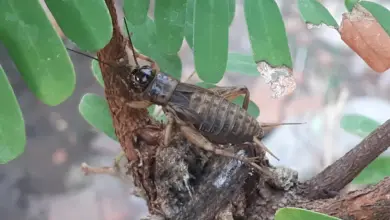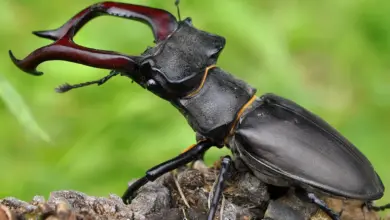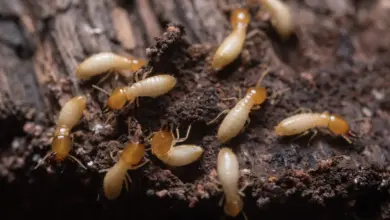Thrips are tiny, slender insects that can be a nuisance to various plants by causing damage through feeding or vectoring plant diseases. They belong to the order Thysanoptera, which is characterized by their fringed wings. You might wonder where these pesky insects originate from and how they find their way to your precious plants.
Now, let’s dive into the world of thrips and their origin. These minuscule creatures are found across the globe, adapting to diverse environments. In fact, there are about 5000 known species of thrips, with some even being predatory. Interestingly, it’s not always easy to identify thrips species due to their small size and varied characteristics. So, as you start learning about where thrips come from, it’s essential to understand their biological diversity and the environments they inhabit.
[ez-toc]
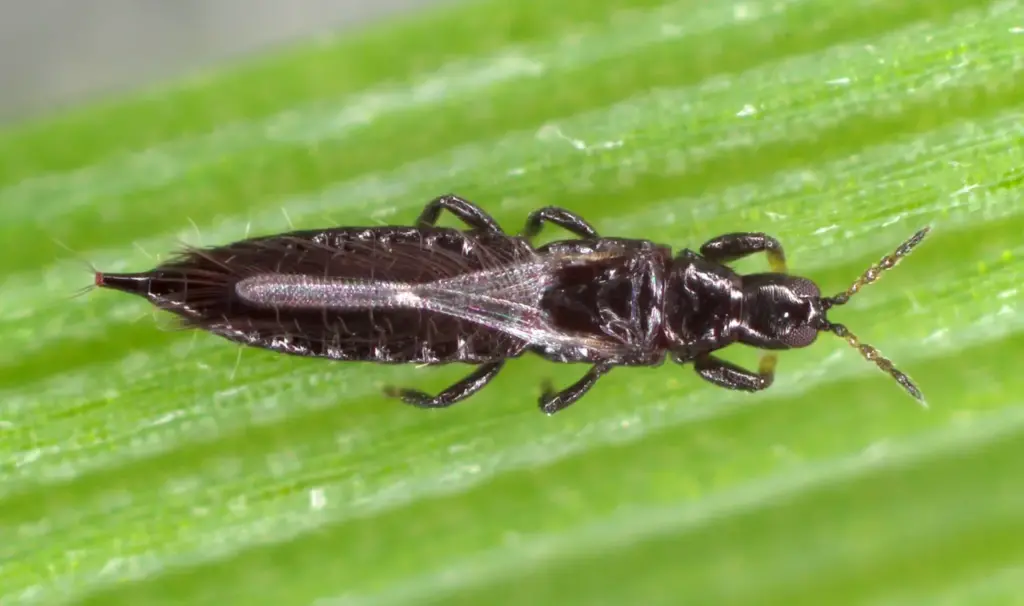
Understanding Thrips
Thrips are small, slender insects belonging to the order Thysanoptera. They have fringed wings, and the adults feed by puncturing the outer layer of plant tissue, causing damage to crops and ornamental plants. Let’s learn some more about thrips and their characteristics.
There are two suborders of thrips: Terebrantia and Tubulifera. These tiny insects come in various sizes and colors, with many generations occurring throughout the year. Here are some features of thrips:
- Adult thrips have fringed wings
- They can cause damage to plants by puncturing their outer layer
- Thrips reproduce quickly, resulting in many generations in a short time
Some common types of thrips include Western flower thrips, Onion thrips, and Citrus thrips. Although they can be destructive to plants, thrips also serve as a food source for predatory insects, contributing to the balance of the ecosystem.
In conclusion, understanding thrips helps you better manage and protect your plants from these tiny insects. So, keep an eye out for thrips and ensure the health and well-being of your garden or farm.
Thrips Life Cycle
Thrips go through several stages in their life cycle, starting with eggs. Adult females deposit their eggs into plant tissue, such as leaves or fruit.
The eggs hatch, and the emerging larvae actively feed on plant cells. This stage lasts for about a week, depending on factors like temperature and humidity.
Some key features of thrips life cycle:
- Females deposit eggs into plants
- Larvae actively feed on plant tissue
- Non-feeding pupal stage before becoming an adult
After the larval stage, thrips transition into a pupal stage, which is a resting period. The pupal stage takes a few more days, after which they become adults. These adults then mate, and the cycle continues.
In greenhouses, most adult thrips are females, and reproduction without fertilization is common. They often gather in large numbers on the same leaf or flower.
It’s important for you to remember that the length of the thrips life cycle is strongly influenced by factors such as temperature and humidity. Keep these factors in mind while dealing with or trying to prevent a thrips infestation.
Thrips Diets and Feeding Habits
On Leaves and Stems
Thrips are tiny insects that feed on the outer layer of plant tissue. They puncture the epidermal layer and suck out the cell contents, causing stippling, discolored flecking or silvering of the leaf surface. You may also notice black, varnishlike flecks of their excrement on the leaves.
When they feed on your greenhouse plants, their damage can be visible on leaves, stems, and foliage. In high populations, thrips can even cause leaves to become distorted, curled or twisted.
Pollen and Flowers
Thrips are also found feeding on pollen and flowers of various plants, including onions, beans, and tomatoes. Their feeding results in the disruption of normal flowering processes, dropping of buds, and reduced fruit set. It’s important to check your flowering plants for any sign of thrips infestation.
Characteristics of thrips damage on flowers:
- Fading or browning of petals
- Twisted or deformed flowers
- Pollen staining on petals
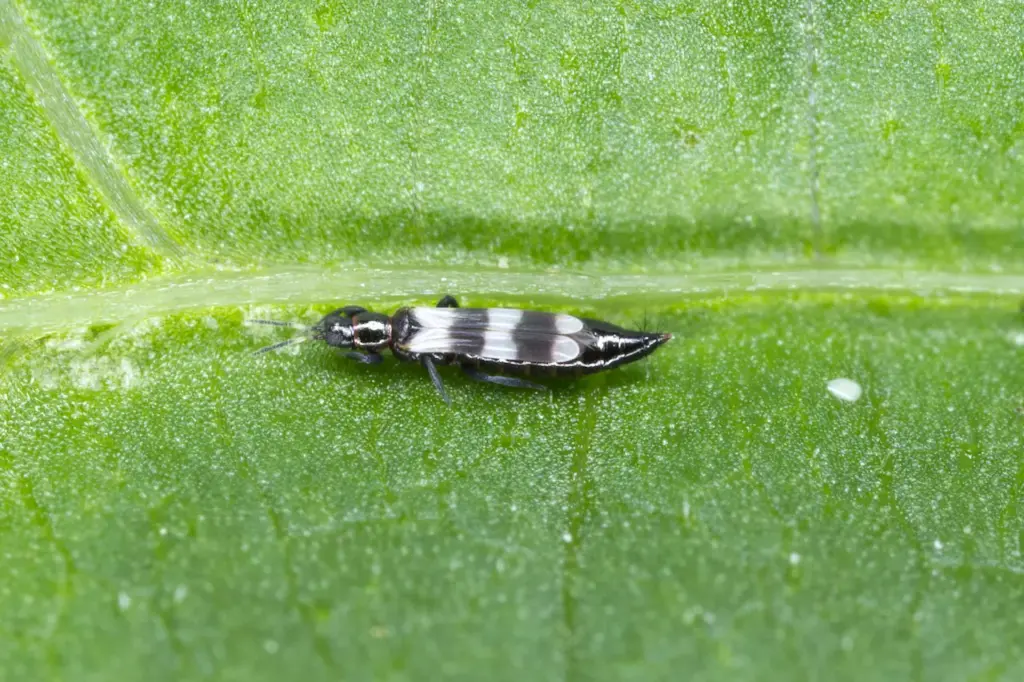
On Fruits and Vegetables
Thrips can cause damage to a variety of fruits and vegetables. For example, the greenhouse thrips can affect avocado fruits when a colony of thrips feed on the fruit in a group over an extended period of (25 thrips-weeks, for instance). The result can be a 0.75 inch diameter sunken area on fruit. Other vegetables that may be affected include tomatoes, beans, and onions.
To minimize damage caused by thrips on your fruits and vegetables:
- Monitor and manage their population
- Encourage natural predators
- Use appropriate and safe insecticides if necessary
By understanding the diets and feeding habits of thrips, you’ll be better prepared to keep these pests under control in your greenhouse, garden, or farm.
Common Types of Thrips
Western Flower Thrips
Western flower thrips are small, slender insects measuring about 0.06 inches (1.5 mm) long. They are pale yellow to light brown in color and have two pairs of wings fringed with long hairs1. These thrips can cause damage to a variety of plants, including flowers and vegetables.
- Damage may include deformation of flowers and leaves
- Silvery streaking and flecking on leaves may be present with their feeding2
Onion Thrips
Onion thrips are another common variety, slightly smaller in size, measuring 0.05 inches (1.3 mm) long3. Similar to the Western flower thrips, they also bear two pairs of fringed wings.
- Prefers feeding on onions, but can also attack other plants
- May cause silvery or brown patches on leaves
Greenhouse Thrips
As the name suggests, greenhouse thrips tend to populate greenhouses and indoor plants. These thrips are a bit different in appearance to the previous varieties, having larvae that are yellow with black pupae5.
- Likely to cause leaf drop and distorted growth in affected plants
- Leaves may have black fecal specks present
Avocado Thrips
Avocado thrips, as you can guess, primarily attack avocado trees. They are the smallest among these thrips varieties and can cause severe damage to avocado leaves, leading to reduced fruit production.
- May contribute to irregular, reduced fruit growth
- Affected leaves can develop necrotic (dead) patches or abscission (leaf drop)7
In summary, thrips come in various types, with each preferring specific plants or environments. While they may vary slightly in appearance and size, they all have the same wing structure and can cause significant damage to their preferred hosts.
Thrips Infestation
Thrips are tiny, slender insects that can cause significant damage to plants. They are known to infest various types of plants, leading to a decline in their health and appearance. Thrips feed on plant tissues by puncturing the epidermal layer and sucking out the contents, causing visible damage1. Some common signs of thrips infestation include:
- Discolored, distorted, or damaged leaves and flowers
- Silvering or speckling on the leaf surface
- Premature dropping of flowers or buds
These pests can also transmit plant diseases, such as viruses, which can further weaken the plant and cause more severe damage2.
Early detection of a thrips infestation is crucial as it is easier to control when the infestation size is small3. One method to detect thrips is to place a white piece of paper under open flowers and gently tap the flower. If thrips are present, they will fall onto the paper and be visible.
To reduce the risk of thrips infestation in your plants, you can:
- Regularly monitor your plants for signs of damage or disease
- Remove any infected or damaged plant material and dispose of it properly
- Encourage natural predators, such as predatory mites and parasitic wasps, by providing a suitable habitat for them4.
In summary, it’s essential to keep an eye on your plants for any signs of thrips infestation, and take action quickly to prevent further damage and the spread of plant diseases. With proper care and attention, you can minimize the impact of thrips on your plants and ensure their health and vitality.
Thrips and Plant Diseases
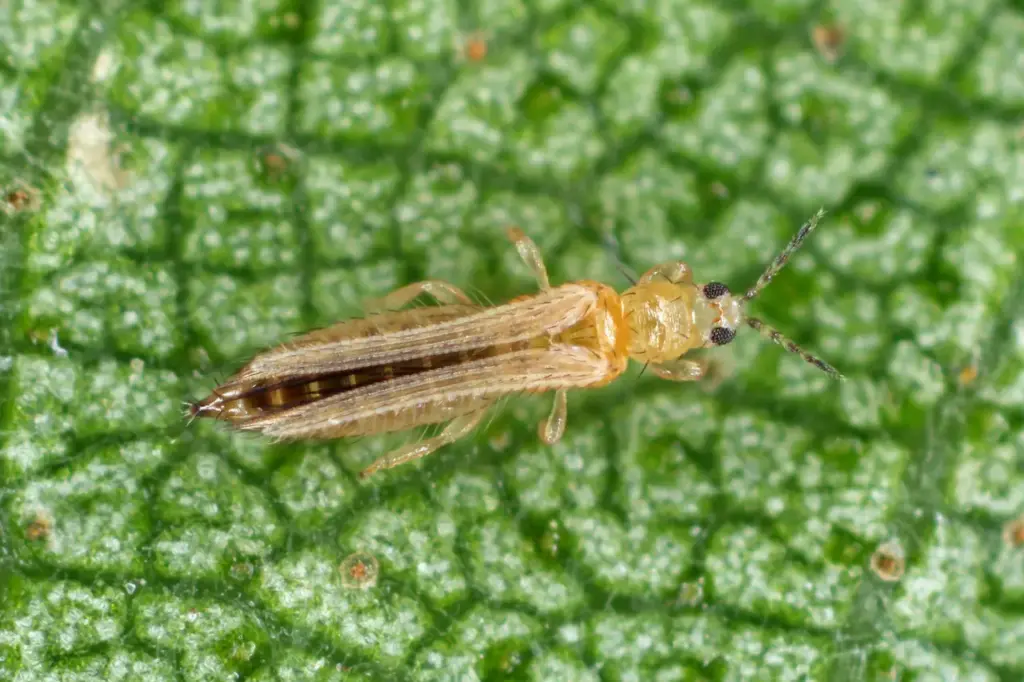
Tomato Spotted Wilt Virus
Thrips can spread various plant diseases, including the Tomato Spotted Wilt Virus (TSWV). This virus affects many plants, causing significant damage to tomatoes, peppers, and other crops. Symptoms may include:
- Mottling or chlorotic spots on leaves
- Necrosis of leaf tissue
- Stunted growth or reduced yield
To reduce the risk of TSWV, you can implement various management practices, such as:
- Monitoring thrips populations in your garden
- Removing infected plants and weeds
- Using reflective mulches to deter thrips
Impatiens Necrotic Spot Virus
Another virus transmitted by thrips is the Impatiens Necrotic Spot Virus (INSV). This virus mainly affects ornamental plants like impatiens, but it can also infect other crops. Some common symptoms include:
- Necrotic lesions on leaves
- Ring-like patterns on infected foliage
- Yellowing or wilting of the plant
Just like TSWV, managing thrips populations is crucial in preventing the spread of INSV. You can achieve this by:
- Regularly inspecting your plants for thrips
- Introducing predatory insects to your garden
- Applying appropriate insecticides when necessary
Remember that maintaining a healthy garden and keeping thrips populations in check can help minimize the risk of these plant diseases. Make sure to monitor your plants regularly and take action when needed.
Controlling Thrips
Using Insecticidal Soap
Insecticidal soaps can be an effective way to control thrips. These soaps can suffocate the insects and help you get rid of thrips. To use this method, follow these steps:
- Mix a solution of insecticidal soap according to the label’s instructions.
- Apply the soap solution to the affected plants, making sure to cover both the top and bottom of leaves.
Keep in mind that this method may need to be repeated multiple times for effective control.
Employing Biological Control
Another way to control thrips is by introducing beneficial insects that prey on thrips, such as pirate bugs, lacewings, ladybugs, and parasitic wasps. These predators can help control the thrips population, reducing the need for pesticides. Here are some examples of biological control methods:
- Pirate bugs: These small insects can attack and kill a variety of thrips species.
- Lacewings: These delicate insects are known to feed on thrips larvae.
- Ladybugs: Ladybugs can also prey on thrips and help control their population.
- Parasitic wasps: Certain species of wasps can lay their eggs inside thrips, killing them in the process.
You can release these beneficial insects in your garden or greenhouse to help control thrips.
Applying Pesticides
If other control methods aren’t effective, you may need to resort to using pesticides. Chemicals such as spinosad can be used for controlling thrips. However, it’s essential to use these chemicals responsibly and follow the label’s instructions to minimize negative impacts on the environment and non-target insects.
Here is a comparison table to help you choose the best method for controlling thrips:
| Control Method | Pros | Cons |
|---|---|---|
| Insecticidal Soap | Non-toxic, eco-friendly | Might need multiple applications |
| Biological Control | Natural, reduces pesticide use | Requires careful management |
| Pesticides | Fast acting, effective | Harmful to non-target insects and plants |
When deciding on a control method, consider the severity of your thrips infestation and the impact each method may have on your plants and the environment.
Thrips and Humans
Thrips can be a nuisance to humans due to their penchant for feeding on plants and potentially causing damage to crops. In some cases, they may also bite humans, although it’s not very common. These tiny creatures are often mistaken for other insects like whiteflies, mite eggs, or small moths.
When you encounter thrips, it’s essential to know their characteristics and habits to deal with them effectively. Here are some key features:
- Tiny, slender insects with fringed wings
- Feed by puncturing the outer layer of host tissue and sucking out the contents
- Can cause damage to crops and plants
- May vector viral diseases in certain circumstances
Thrips can be managed with a combination of methods such as biological control, use of insecticides, or proper cultural practices. For example, introducing natural enemies like predatory mites or parasitic wasps can help keep their population in check.
To distinguish between thrips and other similar-looking insects, you may use a hand lens or magnifying glass to examine their size, wing structure, and color. Compared to whiteflies or moths, thrips are smaller, and their wings are fringed with long hairs.
In conclusion, thrips may not pose a significant threat to humans through bites or other physical harm, but their potential to damage plants and crops can be problematic. By understanding their features and habits, you can identify and manage them more effectively.
Miscellaneous Information about Thrips
Thrips are tiny, slender insects typically found in soil, gardens, and on a variety of plants. They can enter your home through doors and windows, infesting your houseplants and outdoor plants as well. Thrips come in a range of colors, including brown, blue, white, black, and yellow. Some species, like the greenhouse and corn flies, are specific to certain habitats and host plants.
These insects can be harmful to your plants as they feed on plant nutrients and cause damage. At the same time, they can aid in pollination. Adult female thrips can lay their eggs in plant tissue adding to their population.
To manage thrips populations, consider implementing preventative measures. For example:
- Maintaining proper moisture levels in your garden
- Regularly inspecting your plants for signs of infestation
- Using diatomaceous earth on the ground and potted plants
When dealing with thrips, it is essential to keep in mind that they are not harmful to pets. They are, however, often confused with spider mites – another plant pest. To differentiate between the two, remember that thrips are generally larger and more mobile.
Comparison between Thrips and Spider Mites:
| Feature | Thrips | Spider Mites |
|---|---|---|
| Size | Larger (1 to 2 mm) | Smaller (0.4 mm) |
| Mobility | Highly mobile | Less mobile |
| Plant damage | Feed on plant nutrients, causing discoloration | Feed on plant cells, causing stippling appearance |
Knowing these facts about thrips can help you make better decisions when dealing with them in your home and garden. Remember to keep up with regular plant care and consider using natural methods to manage thrips populations, ensuring your plants stay healthy and thriving.

